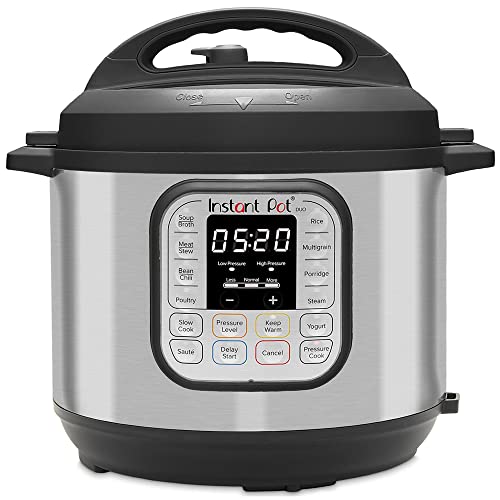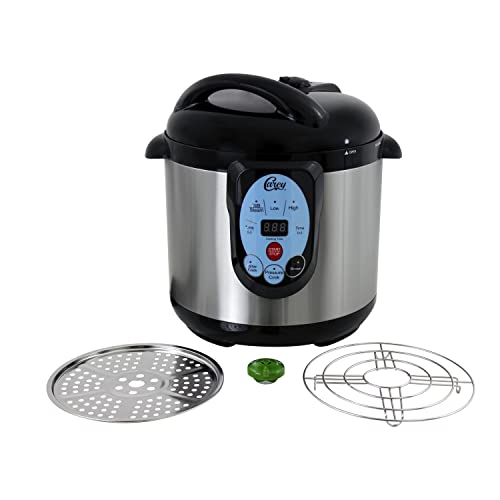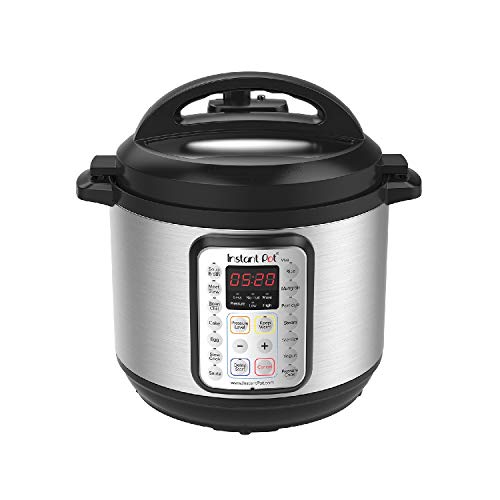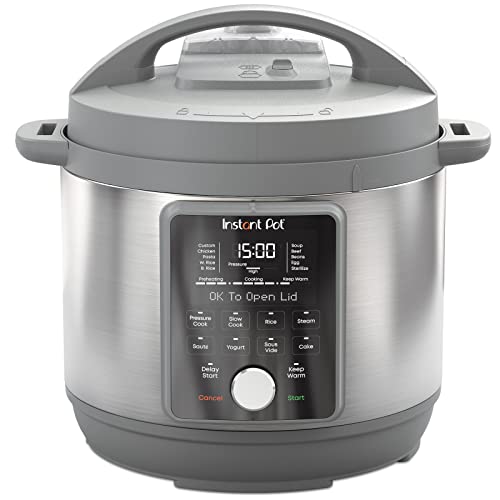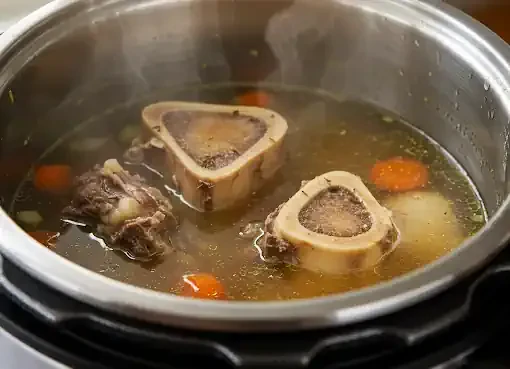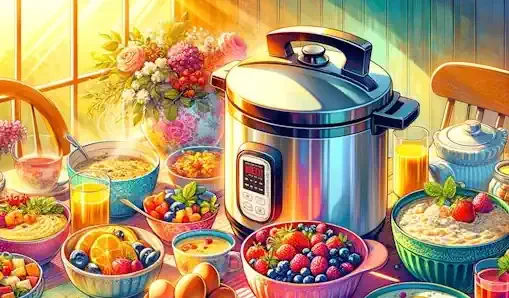Electric pressure cookers are versatile, easy to use, and can help save time and energy when preparing meals. However, there has been some debate about whether or not electric pressure cookers can be used for canning. In this article, we will explore the use of electric pressure cookers for canning and provide some tips and advice for those who are interested in trying it out.
First, it's important to understand that electric pressure cookers are not recommended for canning by the U.S. Department of Agriculture (USDA). This is because electric pressure cookers do not provide consistent and reliable pressure or temperature control, which is essential for safe and effective canning.
If you are interested in canning, it's important to invest in a dedicated canning pot or pressure canner that is specifically designed for this purpose. These pots and canners are designed to provide consistent pressure and temperature control, ensuring that your canned foods are safe and free from harmful bacteria.
However, some electric pressure cooker manufacturers have begun to market their products as suitable for canning. While it may be tempting to use your electric pressure cooker for canning, it's important to do so with caution and to understand the potential risks involved.
If you do decide to use your electric pressure cooker for canning, there are a few important things to keep in mind. First, be sure to carefully follow the manufacturer's instructions for canning, and never exceed the recommended pressure or temperature settings. It's also important to use only tested canning recipes that have been approved by the USDA, as these recipes are designed to ensure safe and effective canning.
Another important consideration when using an electric pressure cooker for canning is the size of the pot. Most electric pressure cookers are not large enough for canning large batches of food, which can increase the risk of spoilage and contamination. If you do decide to use your electric pressure cooker for canning, be sure to work in small batches and to follow the recommended processing times carefully.
Finally, it's important to understand the potential risks involved with using an electric pressure cooker for canning. The USDA does not recommend using electric pressure cookers for canning, as they do not provide consistent pressure or temperature control, which can increase the risk of spoilage and contamination.
Electric Pressure Cookers for Canning
Canning, a time-honored method of food preservation, has been a cornerstone of culinary practices for generations, allowing households to enjoy the bounty of harvest throughout the year. Traditionally, this process involved meticulous attention to detail, precise timing, and the careful orchestration of heat and pressure in large pots atop stovetops. While effective, traditional canning methods are not without their challenges, often demanding significant time investments and a degree of expertise that can intimidate novice canners.
The Legacy of Traditional Canning Methods
Traditional canning methods have been revered for their ability to transform seasonal abundance into pantry staples, from vibrant jams to savory pickles. The process typically involves heating food in glass jars to high temperatures to kill bacteria, followed by sealing the jars to create a vacuum that prevents spoilage. Despite its effectiveness, traditional canning requires vigilance to prevent underprocessing or overprocessing, which can compromise food safety and quality. Moreover, the reliance on stovetop equipment and manual monitoring adds a layer of complexity to the process.
Enter Electric Pressure Cookers (EPCs)
In recent years, the culinary landscape has witnessed the rise of electric pressure cookers (EPCs) as a modern solution to traditional cooking challenges. These versatile appliances, equipped with advanced technology and user-friendly features, have revolutionized meal preparation with their ability to cook food quickly and efficiently under pressure. While initially hailed for their prowess in preparing everyday meals, EPCs have also piqued the interest of home canners seeking a more convenient and streamlined approach to preserving foods.
The Promise of Electric Pressure Cookers for Canning
The intersection of technology and tradition has given rise to a new frontier in home canning, with electric pressure cookers emerging as a promising alternative to traditional canning methods. By harnessing the power of steam and pressure, EPCs offer a controlled environment for safely processing canned goods, reducing the need for constant supervision and manual adjustments. This fusion of innovation and tradition holds the potential to democratize the art of canning, making it more accessible to novice canners while retaining the time-honored principles of food preservation.
Navigating the Transition
As home cooks and canning enthusiasts embark on this new chapter in food preservation, it's essential to approach the use of electric pressure cookers for canning with caution and curiosity. While EPCs offer unparalleled convenience and efficiency, they also present unique challenges and considerations that warrant careful attention. By understanding the capabilities and limitations of electric pressure cookers, canners can embark on a journey of exploration and experimentation, unlocking new possibilities in the world of home preservation.
Understanding Electric Pressure Cookers (EPCs)
Electric pressure cookers (EPCs) represent a fusion of traditional pressure cooking techniques with modern technology, offering a convenient and efficient solution for busy households. Understanding the inner workings of these kitchen appliances is essential for harnessing their full potential in the realm of canning.
Mechanics of Electric Pressure Cookers
At the heart of every electric pressure cooker lies a simple yet sophisticated mechanism for transforming water into steam under high pressure. The cooking pot, typically made of durable stainless steel or non-stick materials, serves as the vessel for food preparation. A tightly sealed lid, equipped with a silicone or rubber gasket, ensures that steam cannot escape during the cooking process, creating a pressurized environment that accelerates cooking times.
Safety Features and Mechanisms
Safety is paramount when it comes to electric pressure cookers, and modern models are equipped with an array of features designed to prevent accidents and ensure user confidence. One such feature is the locking lid mechanism, which prevents the lid from being opened while the cooker is pressurized, safeguarding against steam-related injuries. Additionally, built-in pressure release valves allow excess steam to escape in controlled bursts, preventing the buildup of excessive pressure.
Versatility and Functionality
One of the key appeals of electric pressure cookers lies in their versatility, offering a multitude of cooking functions beyond pressure cooking alone. Many modern EPCs are equipped with preset cooking programs for common dishes such as rice, soup, and yogurt, simplifying meal preparation for busy households. Furthermore, some models feature additional functions such as sautéing, steaming, and slow cooking, further expanding their culinary capabilities.
Understanding Pressure Settings
Central to the operation of electric pressure cookers is the ability to control pressure levels according to the requirements of different recipes. Most EPCs offer multiple pressure settings, typically denoted by low, medium, and high pressure options. Understanding how these pressure settings affect cooking times and outcomes is essential for achieving optimal results when canning foods of varying densities and textures.
Maintenance and Care
Proper maintenance and care are crucial for ensuring the longevity and performance of electric pressure cookers. Regular cleaning of the cooking pot, lid, and sealing gasket helps prevent the buildup of food residues that can affect cooking performance and safety. Additionally, periodic inspection of safety mechanisms such as pressure release valves ensures that the cooker remains in optimal working condition.
Understanding the inner workings and capabilities of electric pressure cookers lays the foundation for harnessing their full potential in the realm of canning. With proper knowledge and care, these versatile appliances offer a convenient and efficient solution for preserving seasonal bounty and expanding culinary horizons.
Safety Considerations
Safety is paramount when it comes to any food preservation method, and canning with electric pressure cookers (EPCs) is no exception. While EPCs offer convenience and efficiency, it's essential to understand and adhere to safety guidelines to ensure the preservation of both food quality and consumer health.
Manufacturer Guidelines and Recommendations
Before embarking on the journey of canning with an electric pressure cooker, it's imperative to familiarize oneself with the manufacturer's guidelines and recommendations. Not all EPC models are designed for canning, and using the wrong type of cooker can pose serious safety risks. Manufacturers typically provide specific instructions for canning, including recommended pressure levels, processing times, and maximum jar capacities. Adhering to these guidelines is crucial for ensuring safe and successful canning outcomes.
Understanding Botulism Risk
Botulism, a rare but potentially deadly form of food poisoning caused by the Clostridium botulinum bacterium, is a primary concern when it comes to home canning. Unlike other forms of foodborne illness, botulism thrives in low-acid, anaerobic environments such as improperly canned foods. Electric pressure cookers offer a controlled environment for canning, but failure to follow proper procedures can create conditions conducive to botulism growth. Understanding the risk factors and symptoms of botulism is essential for practicing safe canning techniques and ensuring the integrity of preserved foods.
Proper Jar Preparation and Handling
The integrity of the canning jars is critical to the success of the canning process. Before use, jars should be thoroughly cleaned and inspected for any signs of damage or defects, such as chips or cracks. Additionally, proper jar handling techniques, such as using jar lifters to transfer hot jars in and out of the pressure cooker, help minimize the risk of burns and injuries during the canning process. Ensuring that jars are properly sealed and stored after canning is also essential for preserving food quality and safety.
Monitoring Pressure and Temperature
Maintaining precise control over pressure and temperature is key to safe and effective canning with electric pressure cookers. Throughout the canning process, it's essential to monitor pressure levels closely and make adjustments as needed to ensure that they remain within the recommended range for the type of food being canned. Additionally, using a reliable thermometer to monitor the temperature of the food during processing helps ensure that it reaches the necessary heat levels to destroy harmful bacteria effectively.
Adhering to Processing Times
Proper processing times are critical for achieving safe and effective canning outcomes. Processing times vary depending on factors such as the type of food being canned, jar size, and altitude. It's essential to consult reputable canning resources, such as the USDA Complete Guide to Home Canning, for accurate processing time recommendations based on scientific research and testing. Failure to adhere to recommended processing times can compromise food safety and quality, increasing the risk of spoilage and contamination.
By understanding and adhering to safety considerations when canning with electric pressure cookers, home canners can enjoy the convenience and efficiency of this modern preservation method while minimizing the risk of foodborne illness and ensuring the long-term viability of preserved foods.
Suitable Foods for Canning in Electric Pressure Cookers
Choosing the right foods for canning in electric pressure cookers (EPCs) is essential for achieving safe and successful preservation outcomes. While EPCs offer convenience and efficiency, not all foods are suitable for canning using this method. Understanding the characteristics of different foods and their compatibility with electric pressure canning is crucial for maximizing the benefits of this modern preservation technique.
High-Acid Foods
High-acid foods, such as fruits, pickles, and most tomatoes, are well-suited for canning in electric pressure cookers. These foods naturally contain acids that inhibit the growth of harmful bacteria, making them less susceptible to spoilage and contamination. Additionally, the high-temperature steam generated by EPCs effectively destroys any remaining bacteria, ensuring the safety and quality of canned high-acid foods. Popular high-acid recipes for electric pressure canning include fruit jams and jellies, pickled vegetables, and salsa.
Low-Acid Foods
Low-acid foods, such as vegetables, meats, poultry, and seafood, require special consideration when canning with electric pressure cookers. Unlike high-acid foods, low-acid foods have a pH level above 4.6, making them more susceptible to bacterial growth and spoilage. While electric pressure cookers can safely process low-acid foods, it's essential to follow specific guidelines and recommendations to ensure safety. This may include using adequate pressure levels and processing times to destroy harmful bacteria effectively. Common low-acid recipes suitable for electric pressure canning include vegetable soups, meat stews, and bean-based dishes.
Densely Packed Foods
When canning in electric pressure cookers, it's important to consider the density and texture of the foods being preserved. Densely packed foods, such as whole fruits and vegetables, require longer processing times and higher pressure levels to ensure thorough heating and sterilization. Failure to adequately process densely packed foods can result in underprocessing, increasing the risk of spoilage and contamination. Proper packing techniques, such as leaving adequate headspace in jars and arranging foods in layers, help ensure uniform heating and effective preservation.
Preparing Foods for Canning
Proper preparation of foods is crucial for successful canning in electric pressure cookers. Before canning, fruits and vegetables should be thoroughly washed and inspected for any signs of damage or decay. Meats and poultry should be trimmed of excess fat and bones, while seafood should be cleaned and scaled. Additionally, it's important to follow recommended procedures for blanching, peeling, and slicing fruits and vegetables to ensure even cooking and optimal preservation. By taking the time to prepare foods properly, home canners can maximize the quality and shelf life of their canned goods.
Selecting suitable foods for canning in electric pressure cookers is the first step towards successful preservation. By understanding the characteristics of different foods and following recommended procedures, home canners can harness the convenience and efficiency of EPCs to create delicious and nutritious canned goods for year-round enjoyment.
Preparation Process
Preparing food and jars properly before canning in electric pressure cookers (EPCs) is essential for ensuring the safety, quality, and longevity of preserved foods. From sanitation to packing, following thorough preparation procedures is crucial for successful canning outcomes.
Sanitation and Hygiene
Maintaining cleanliness and hygiene throughout the canning process is paramount to prevent contamination and spoilage. Before beginning, thoroughly wash all equipment, including the electric pressure cooker, canning jars, lids, and utensils, with hot, soapy water. Rinse everything well to remove any soap residue. Pay particular attention to sealing gaskets and pressure release valves to ensure they are clean and free of debris. Additionally, wash hands frequently and use clean towels or paper towels to prevent the spread of bacteria.
Jar Preparation
Proper preparation of canning jars is essential for creating a safe and effective seal. Inspect each jar for cracks, chips, or defects, and discard any jars that are damaged. Wash jars in hot, soapy water, then rinse thoroughly to remove any soap residue. Sterilize the jars by placing them in boiling water for 10 minutes or running them through a dishwasher cycle. Keep the jars hot until ready to use by placing them in a warm oven or immersing them in hot water.
Food Preparation
Preparing the food for canning requires careful attention to detail to ensure even cooking and optimal flavor. Wash fruits and vegetables thoroughly under running water, removing any dirt or debris. Trim, peel, and slice as necessary, following recommended procedures for each type of food. For meats and poultry, trim excess fat and remove bones before cutting into pieces of uniform size. Properly prepare seafood by cleaning, scaling, and filleting as needed.
Packing the Jars
Proper packing of the jars is crucial for achieving a tight seal and ensuring even heat distribution during processing. Pack prepared food tightly into hot, sterilized jars, leaving the recommended amount of headspace specified in the recipe. Use a bubble remover tool or wooden spoon to remove any air bubbles trapped in the food. Wipe the rims of the jars with a clean, damp cloth to remove any food particles or residue that could prevent a proper seal. Place sterilized lids on the jars and screw on the bands fingertip tight.
Preheating the Electric Pressure Cooker
Before loading the jars into the electric pressure cooker, preheat the cooker according to the manufacturer's instructions. This helps ensure that the cooker reaches the desired pressure more quickly once the jars are added, reducing the overall processing time. Preheating also helps prevent thermal shock to the jars, which can occur if they are added to a cold cooker and increase the risk of breakage.
By following thorough preparation procedures, home canners can set the stage for safe, successful, and delicious canning outcomes with electric pressure cookers. From sanitation to packing, attention to detail at every step of the preparation process is essential for preserving the integrity of the food and maximizing its shelf life.
Canning Procedures
Executing proper canning procedures is essential for achieving safe and effective preservation outcomes when using electric pressure cookers (EPCs). From loading the cooker to adjusting pressure settings, following a systematic approach ensures that foods are processed correctly and preserved for long-term storage.
Loading the Electric Pressure Cooker
Carefully arrange the prepared jars in the electric pressure cooker, ensuring they are stable and not touching each other or the sides of the cooker. Leave adequate space between jars to allow for proper circulation of steam and heat during processing. Avoid overcrowding the cooker, as this can impede the flow of steam and result in uneven cooking. If necessary, process foods in multiple batches to ensure that each jar receives proper heat distribution.
Setting Pressure and Processing Time
Once the jars are loaded into the electric pressure cooker, set the pressure and processing time according to the recipe or manufacturer's instructions. Select the appropriate pressure level based on the type of food being canned and the altitude of your location. Consult reputable canning resources, such as the USDA Complete Guide to Home Canning, for recommended pressure levels and processing times for different foods.
Bringing the Cooker to Pressure
After setting the pressure and processing time, allow the electric pressure cooker to come to pressure. This typically involves heating the cooker until steam begins to escape from the pressure release valve, at which point the cooker will seal shut and pressurize. Depending on the model, this process may take several minutes to reach the desired pressure level. Once the cooker has reached pressure, the processing time will begin.
Monitoring the Canning Process
Throughout the canning process, it's essential to monitor the electric pressure cooker closely to ensure that it maintains the desired pressure level and temperature. Some models may feature built-in indicators or displays that show the current pressure and processing time, while others may require manual monitoring. Adjust the heat as needed to maintain a steady pressure level and prevent fluctuations that could compromise the safety and quality of the canned food.
Allowing for Natural Pressure Release
Once the processing time is complete, allow the electric pressure cooker to naturally release pressure before opening the lid. Depending on the model and the amount of food being canned, this may take several minutes to an hour. Avoid manually releasing pressure by opening the pressure release valve, as this can cause rapid depressurization and may result in food spoilage or safety hazards. Once the pressure has fully released, carefully remove the jars from the cooker using jar lifters or tongs.
Following proper canning procedures ensures that foods are processed safely and effectively, preserving their quality and flavor for long-term storage. By loading the cooker correctly, setting appropriate pressure levels and processing times, and monitoring the canning process closely, home canners can achieve successful preservation outcomes with electric pressure cookers.
Monitoring and Troubleshooting
Vigilant monitoring and prompt troubleshooting are essential aspects of successful canning with electric pressure cookers (EPCs). Throughout the canning process, maintaining a close watch allows for early detection of any issues that may arise, ensuring the safety and quality of the preserved foods.
Monitoring Pressure and Temperature
Continuous monitoring of pressure and temperature levels within the electric pressure cooker is crucial for ensuring the safe and effective processing of canned foods. Keep an eye on the pressure gauge or indicator to ensure that the cooker maintains the desired pressure level throughout the processing time. Additionally, use a reliable thermometer to monitor the temperature of the food inside the jars, verifying that it reaches the recommended temperature for safe preservation.
Adjusting Heat and Pressure
If the pressure or temperature levels deviate from the desired range during the canning process, take prompt action to adjust the heat settings accordingly. Increase or decrease the heat as needed to maintain a steady pressure level and prevent fluctuations that could compromise the safety and quality of the canned food. Additionally, adjust the pressure settings if necessary to ensure that the food is processed at the appropriate pressure level for the recommended duration.
Addressing Steam Leaks
Occasionally, steam leaks may occur around the lid of the electric pressure cooker during the canning process, compromising the effectiveness of the sealing mechanism. If steam leaks are detected, check the sealing gasket and pressure release valve for any signs of damage or obstruction. Tighten the lid securely to ensure a proper seal, and avoid opening the cooker until the processing time is complete to prevent steam loss.
Troubleshooting Processing Issues
If issues such as underprocessing or overprocessing are encountered during the canning process, take immediate steps to address them to prevent food spoilage and ensure safety. If jars are found to be underprocessed, return them to the electric pressure cooker and reprocess them at the appropriate pressure level and processing time. Conversely, if jars are found to be overprocessed, take note of the error and adjust processing times accordingly for future batches.
Ensuring Safe Storage
Once the canning process is complete, allow the jars to cool naturally before handling them. Once cooled, check the seals of the jars to ensure they are tight and secure. Label each jar with the contents and date of canning, and store them in a cool, dark place away from direct sunlight and heat sources. Properly stored canned foods can remain safe for consumption for up to a year or more, providing a convenient and nutritious pantry staple.
By maintaining vigilant monitoring and addressing any issues that arise promptly, home canners can ensure the safety and quality of their canned foods when using electric pressure cookers. With careful attention to detail and troubleshooting techniques, successful preservation outcomes can be achieved, providing a bounty of delicious and nutritious foods for enjoyment throughout the year.
Benefits of Using Electric Pressure Cookers for Canning
Electric pressure cookers (EPCs) offer a range of benefits when it comes to canning, making them an attractive option for home canners seeking convenience, efficiency, and reliable results. Understanding the advantages of using EPCs for canning can help home canners make informed decisions about their preservation methods and equipment choices.
Time and Energy Efficiency
One of the primary benefits of using electric pressure cookers for canning is their time and energy efficiency. Unlike traditional stovetop canners, which require constant monitoring and adjustment of heat levels, EPCs automate much of the process, allowing for hands-off cooking and freeing up time for other tasks. Additionally, EPCs typically use less energy than stovetop canners, making them a more environmentally friendly option for home canning enthusiasts.
Precise Pressure Control
Modern electric pressure cookers are equipped with advanced pressure control mechanisms that allow for precise adjustment of pressure levels according to the requirements of different recipes. This precise pressure control ensures that foods are processed safely and effectively, minimizing the risk of underprocessing or overprocessing. Additionally, EPCs typically feature built-in safety mechanisms, such as locking lids and pressure release valves, that provide added peace of mind during the canning process.
Retention of Food Quality and Flavor
The high-pressure steam environment created by electric pressure cookers helps to preserve the natural flavors, colors, and textures of foods, resulting in canned goods that retain their quality and freshness over time. Unlike traditional canning methods, which can sometimes lead to overcooked or mushy foods, EPCs allow for precise control over cooking times and temperatures, ensuring that foods are cooked to perfection while maintaining their nutritional value and flavor.
Versatility and Multifunctionality
In addition to canning, electric pressure cookers offer a range of other cooking functions that make them a versatile addition to any kitchen. From pressure cooking and slow cooking to sautéing and steaming, EPCs can handle a wide variety of cooking tasks with ease. This versatility makes EPCs a valuable investment for home cooks looking to streamline their meal preparation and expand their culinary horizons.
Space-Saving Design
Electric pressure cookers are compact and space-saving compared to traditional stovetop canners, making them an ideal option for kitchens with limited counter and storage space. Many models feature a modular design that allows for easy storage when not in use, making them a convenient and practical choice for home canning enthusiasts.
By harnessing the time-saving, energy-efficient, and versatile capabilities of electric pressure cookers, home canners can enjoy the convenience and reliability of modern canning methods while preserving the quality and flavor of their favorite foods for long-term storage. With proper knowledge and equipment, canning with electric pressure cookers opens up a world of possibilities for culinary creativity and preservation prowess.
Limitations and Challenges
While electric pressure cookers (EPCs) offer many benefits for canning, it's important to recognize and address their limitations and challenges to ensure successful preservation outcomes. Understanding these factors allows home canners to navigate potential obstacles and maximize the effectiveness of EPCs in their canning endeavors.
Capacity Limitations
One of the primary limitations of electric pressure cookers for canning is their capacity. Most EPC models have a limited capacity in terms of the number and size of jars they can accommodate, which may not be sufficient for large-scale canning projects or for processing large batches of food at once. Home canners may need to work in smaller batches or invest in multiple EPCs to meet their canning needs efficiently.
Learning Curve
Using an electric pressure cooker for canning requires a learning curve, especially for those who are accustomed to traditional stovetop canning methods. Home canners may need to familiarize themselves with the specific features and functions of their EPCs, as well as learn proper canning procedures and techniques for optimal results. Additionally, troubleshooting issues such as steam leaks or pressure fluctuations may require patience and experimentation to resolve effectively.
Compatibility with Low-Acid Foods
While electric pressure cookers can safely process high-acid foods such as fruits and pickles, they may not be suitable for canning low-acid foods such as vegetables, meats, and poultry. Low-acid foods require higher pressure levels and longer processing times to ensure safe preservation, which may exceed the capabilities of some EPC models. Home canners should consult reputable canning resources and follow recommended procedures for canning low-acid foods with EPCs to minimize the risk of foodborne illness.
Altitude Considerations
Altitude can affect the boiling point of water and the pressure required for safe canning, presenting challenges for home canners using electric pressure cookers. Those living at high altitudes may need to adjust pressure settings and processing times to compensate for lower atmospheric pressure, ensuring that foods are processed safely and effectively. Consultation with local extension services or canning experts can provide valuable guidance on altitude adjustments for canning with EPCs.
Equipment Maintenance
Proper maintenance and care of electric pressure cookers are essential for ensuring their longevity and performance in canning. Regular cleaning and inspection of components such as sealing gaskets, pressure release valves, and pressure gauges help prevent malfunctions and ensure safe operation. Additionally, periodic calibration and testing of pressure levels and temperature accuracy help maintain the reliability and consistency of EPCs for canning.
By acknowledging and addressing the limitations and challenges of electric pressure cookers for canning, home canners can make informed decisions and implement strategies to overcome obstacles effectively. With proper preparation, knowledge, and equipment, canning with electric pressure cookers offers a convenient and efficient method for preserving foods with confidence and success.
Conclusion Electric Pressure Cookers for Canning
Canning with electric pressure cookers (EPCs) represents a modern approach to food preservation that offers convenience, efficiency, and reliable results for home canners. Despite some limitations and challenges, the benefits of using EPCs for canning outweigh the drawbacks, providing an accessible and practical solution for preserving seasonal bounty and creating delicious pantry staples.
Embracing Innovation in Food Preservation
As technology continues to advance, so too do the methods and tools available for food preservation. Electric pressure cookers represent a prime example of innovation in the realm of home canning, offering a convenient and versatile alternative to traditional stovetop canners. By harnessing the power of steam and pressure, EPCs provide home canners with the means to safely and effectively preserve a wide variety of foods for long-term storage.
Empowering Home Canners
Canning with electric pressure cookers empowers home canners to take control of their food preservation efforts and enjoy the fruits of their labor year-round. With proper knowledge, equipment, and procedures, home canners can confidently preserve seasonal produce, create flavorful jams and pickles, and stock their pantries with nutritious and delicious canned goods. The convenience and efficiency of EPCs make canning accessible to novice canners and experienced enthusiasts alike, fostering a sense of pride and accomplishment in the preservation of homemade foods.
Looking Towards the Future
As interest in home canning continues to grow, so too does the potential for innovation and improvement in canning methods and equipment. Electric pressure cookers are just one example of how technology can enhance the canning experience, offering new possibilities for preserving foods safely, efficiently, and deliciously. Looking towards the future, continued research and development in the field of home canning hold promise for further advancements that will benefit home canners and food enthusiasts alike.
In conclusion, electric pressure cookers represent a valuable tool in the modern canner's arsenal, providing a convenient and efficient method for preserving foods with confidence and success. By embracing innovation, empowering home canners, and looking towards the future, canning with electric pressure cookers offers a rewarding journey of culinary creativity, preservation prowess, and delicious homemade delights.

